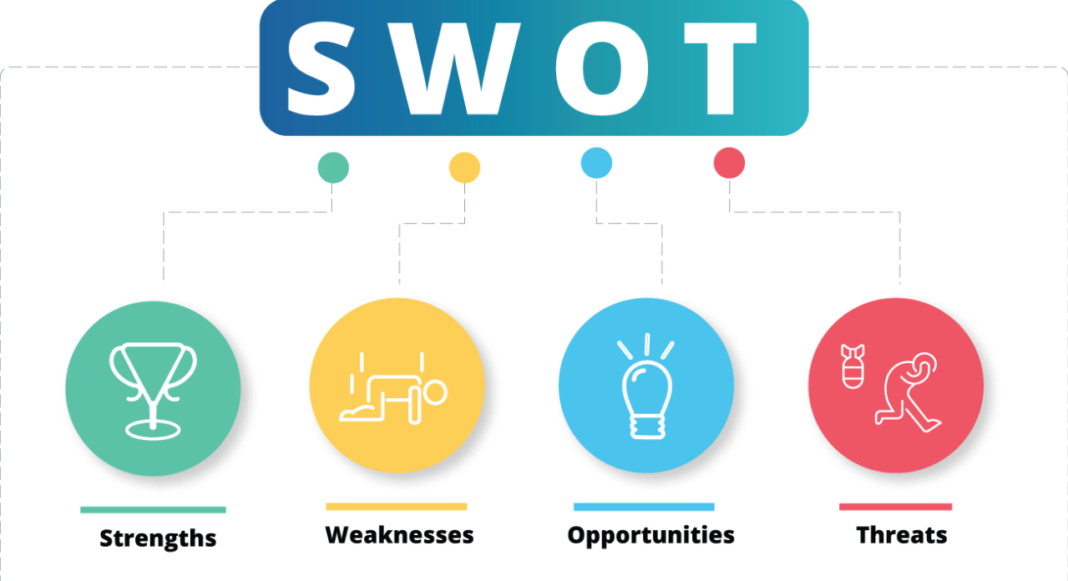What Is SWOT Analysis In a Restaurant?
A SWOT analysis which stands for Strengths, Weaknesses, Opportunities, and Threats, is very useful in assessing the strategic position of a hotel or a restaurant within the industry. Not only for the location but also for many other factors, SWOT analysis is very important conducting often for your property. Let’s have a better understanding of each part within the situation of the Restaurant Industry:
Strengths:
- Prime Location: A restaurant located in a busy or beach area can attract more customers.
- Unique Cuisine: Offering a unique and desirable cuisine can attract customers looking for something different.
- Strong Branding: A well-established brand with a loyal customer base can provide stability and attract new customers through word-of-mouth.
- Experienced Staff: Having skilled chefs and attentive service staff can enhance the overall dining experience.
- Quality Ingredients: Using fresh, locally sourced ingredients can improve the taste and appeal of the dishes.
- Online Presence: A strong online presence through social media and a user-friendly website can attract tech-savvy customers and improve visibility.
Weaknesses:
- High Operating Costs: Running a restaurant involves significant expenses, including rent, utilities, labor, and food costs.
- Seasonal Fluctuations: Sales may vary seasonally, with slower business during certain times of the year.
- Competition: Facing competition from other restaurants in the area can impact market share and profitability.
- Dependence on Reputation: Negative reviews or publicity can significantly affect customer perception and patronage.
- Staff Turnover: High turnover rates among staff can lead to inconsistency in service and quality.
- Limited Menu: Offering a limited menu may alienate customers with diverse tastes and preferences.
Opportunities:
- Online Ordering and Delivery: Offering online ordering and delivery services can tap into the growing demand for convenience.
- Menu Expansion: Introducing new dishes or seasonal specials can attract repeat customers and generate buzz.
- Catering Services: Providing catering services for events and parties can create an additional revenue stream.
- Partnerships: Collaborating with local businesses or food delivery platforms can expand reach and attract new customers.
- Sustainable Practices: Embracing eco-friendly practices, such as using biodegradable packaging or sourcing ingredients from sustainable sources, can attract environmentally conscious customers.
- Diversification: Expanding into related areas such as food retailing or cooking classes can diversify revenue streams.
Threats:
- Economic Downturn: Economic downturns can lead to decreased consumer spending on dining out.
- Food Safety Issues: Foodborne illnesses or health code violations can damage reputation and lead to legal repercussions.
- Changing Consumer Preferences: Shifts in consumer preferences towards healthier options or different cuisines can impact demand.
- Regulatory Changes: Changes in health and safety regulations or labor laws can increase compliance costs and affect operations.
- Rising Costs: Increases in food prices, rent, or labor costs can squeeze profit margins.
- External Events: Natural disasters, political instability, or public health crises (like pandemics) can disrupt operations and reduce foot traffic.
Now that you have a better idea of what SWOT analysis is, let’s have a look at a restaurant SWOT analysis sample compared with another restaurant.
SWOT Analysis Sample
| 4 SEASON RESTAURANT | BELLA RESTAURANT | |
| Strengths | Location: Great location, next to the beach and sea view Unique Cuisine: Wide area for buffet, rich menu, and many varieties and great culinary Brand: Well-known restaurant part of a Hilton Brand Hotels | Entertainment: Have a great popular band Quality of Service: One of the best in the city |
| Weaknesses | Staff Turnover: Not loyal staff and have very often resignations Capacity: Not enough seats | Location: Bad Location, in a crowded area Limited Menu: Doesn’t have many varieties High Operating Costs: High cost of the operating supplies |
| Opportunities | Online Ordering and Delivery: Implementing online ordering to boost the sales Market Expansion: Identifying new target markets or segments | Menu Expansion: New menu and more varieties Diverse Services: Offering additional services |
| Threats | Competition: Intense competition from other Restaurants Economic Downturn: Decreased consumer spending on dining out Online Reputation: Negative reviews and social media feedbacks | Competition: Intense competition from other Restaurants Refurbishment: ASAP as the restaurant is old |
By conducting a SWOT analysis, restaurants can identify key areas for improvement, capitalize on opportunities, mitigate risks, and develop strategies to maintain or increase their competitive edge in the industry.



Very informative, finally i really know the meaning of SWOT analyses
Great delivery. Outstanding arguments. Keep up the great work.
Very informative, thank you for this post. I finally know now the exact meaning of SWOT.
Thanks for the useful post